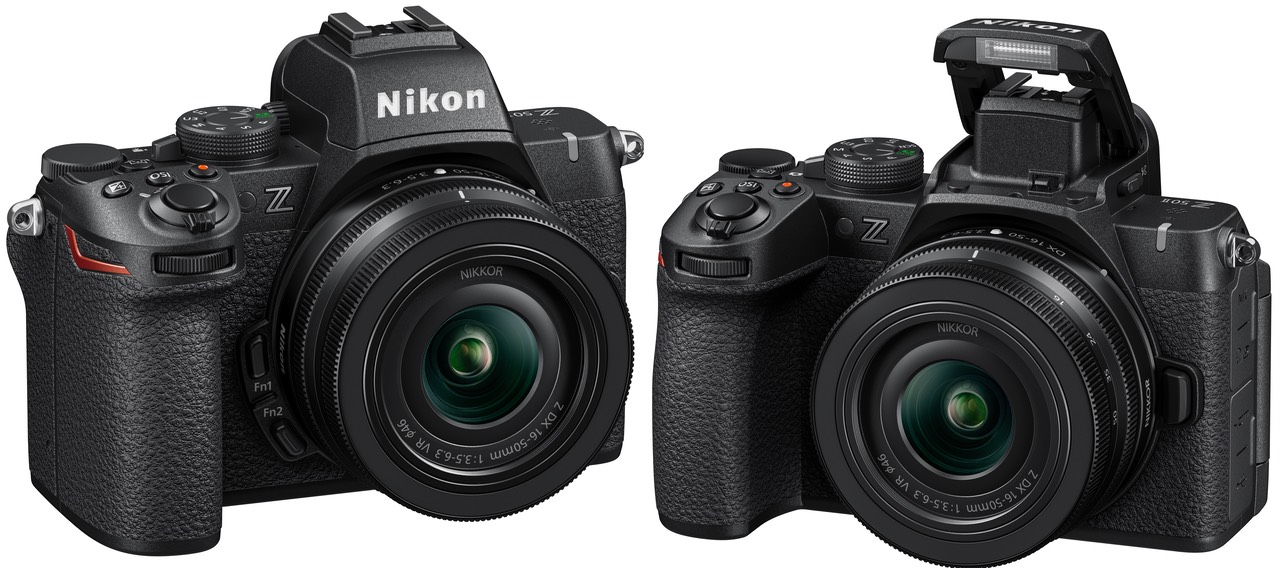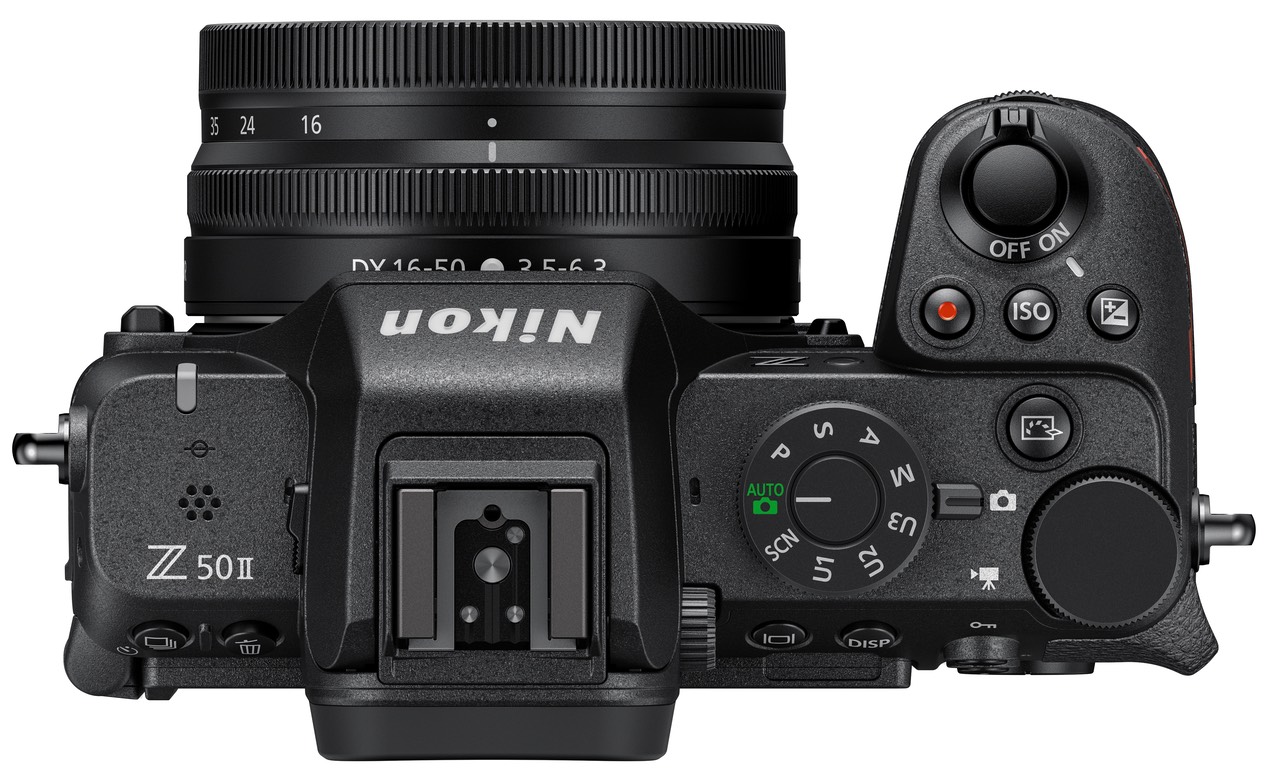Late last month I wrote "I originally had an additional question in this list to answer…” Today I can reveal both the question and the answer. The question was “when will Nikon introduce a new DX camera?” The answer is today. (In my original answer I would have had a prediction date of any time in November or even December, as the EU’s USB-C charging deadline kicks in after Christmas, and the original Z50 should no longer be headed to Europe after that.)

Right up front we need to address an elephant that's now entered the room. By updating a DX model, Nikon is essentially showing a commitment to continuing Z DX. The original Z50 model Is now five years old (plus a couple of weeks), so updating the first DX model suggests that the crop sensor cameras will be around for a fair time longer. That's particularly true given that Nikon is bringing the big Z9 generation improvements to DX now.
So what exactly is a Z50 II?
Basically, a redesigned Z50. While you’ll see clear similarities between the II model and the original, the new body is indeed new: the Z50 II doesn’t have the EVF jutting out the back as much, while the front hand grip has been made a bit more hand friendly. Some buttons and controls have moved. The Rear LCD was changed. Overall, the size of the new model is similar, but more bag friendly due to that limited EVF overhang. Weight has increased substantively to 550g with card and battery (up from 450g), so the Z50 II feels "denser" than the original. And while size is up a bit in the CIPA-standardized measurements, most of you aren't going to notice the small size change.
Yes, I know you’re all screaming “but what about the image sensor and focus?” Patience grasshoppers.
The Z50 II uses the same 20.9mp sensor that Nikon has been using in Z DX since the beginning. To my knowledge, there are no tweaks or changes to its fundamentals—and yes, I asked Nikon and got responses to this question—which I consider fine, since the Nikon 20.9mp sensor has been one of the better APS-C sensors since it first appeared (and then later updated). One early document Nikon shared with me says “reduced noise,” but I believe that comes about due to better JPEG processing. Some will complain “but where are all the pixels?”, however getting back to that elephant I’m pretty sure that Nikon is thinking that if you want more pixels, you should go FX (the Z5 is currently about the same price as the Z50 II). Yes, Nikon was first to 45mp in their (FX) offerings, but they're also showing they're likely going to be one of the last to abandon the 20/24mp base models.
The sensor is not stabilized, so you’ll want to use one of Nikon’s VR lenses with the camera if you need stabilization. Remember, lens VR is two axis, not five, which tends to drop the overall stabilization ability slightly. Not all of the Nikkor DX lenses have CIPA numbers in their technical specifications for VR, but the 18-140mm f/3.5-6.3 VR DX, for instance, is rated at 5 stops at maximum focal length, while the 12-28mm v/3.5-5.6 PZ VR DX is 4.5 stops. This is not quite as good as what you can get from the FX bodies and lenses, but still should prove quite useful.
As expected, EXPEED7 takes over the processing duties, which brings with it all (okay, most) of the Z9 goodness. That includes the Z9 Subject Detection autofocus system, including the dedicated Bird mode, customizable Large-area, as well as 3D-tracking. One new addition to the focus system is a Product review mode. This is where if you suddenly hold something in front of you, the camera will focus on that, then revert to whatever subject detection you were using when you take that object away. If you're wondering what the minimum low light capability of the focus is, Nikon is claiming -9EV (with an f/1.2 lens at base ISO), which is considerably better than the original Z50.
HEIF now makes its debut in DX, as do Portrait impression balance and Skin Softening. We get C15 (15 fps) and C30 (30 fps) release modes, supporting pre-release capture. Maximum mechanical shutter speed stays at 11 fps (also 1 to 5 and 5.6 fps are available). Nikon Imaging Cloud comes along for the ride (I’ll talk about the related aspect of that more in a moment). A number of subtle things, like changing the rear LCD display information orientation when you hold the camera vertically, also come along from the Z9. Meanwhile, the LCD itself is now a 3.2” articulating display, much like the Z30’s.
The EVF is still 2.36m dot, but is now twice as bright. The Z50 maxed out at 500 nits; the Z50 II can be set as high as 1000 nits. Another internal change is UHS II support for the SD storage card (which is necessary for some of the video changes; see next paragraph). Also, the battery is now the EN-EL25a, which has a higher capacity than the older EN-EL25 the Z50 used. CIPA numbers for the battery are down slightly, but remember, this is a camera with an internal flash, and CIPA tests require flash for each image. I judge the new camera to be about 10% more battery hungry, but again, EXPEED7 is at the controls, and it is running more and faster processes.
Video gets a host of improvements, including UHD 4K/60P (though with a 1.5x crop). UHD 4K/30P video is oversampled from 5.6K, which should result in excellent, detailed recordings. The Z50 II is the first DX camera to get N-Log, 10-bit H.265, and Hi-res zoom. N-Log supports the RED LUTs as well as the standard Nikon LUT. There’s a tally lamp on the camera for video, electronic VR has been improved, the camera has waveform monitoring, and the Z50 II now sports a headphone monitoring jack. That headphone jack also supports a new optional (US$37) MC-DC3 wired remote control that plugs into it (the wireless ML-L7 is also supported). Maximum video recording time works out to be about 125 minutes, and I believe that's file size constrained (battery would wear out earlier).
Another interesting change is that the Z50 II doesn’t require Nikon Webcam Utility to stream. The camera directly supports both UVC and UAC streaming via its USB-C port, and applications such as Zoom or Microsoft Teams should immediately detect the camera. My Yololiv switcher supports the Z50 II via USB-C, which means I now have a five-camera switcher.

Next up is what Nikon is touting as the “hero feature” of the Z50 II: a dedicated Picture Control button (on the top right plate; see above) that gives you quick access to not only all the usual 31 Picture Controls (including the most recent three Nikon has introduced), but Image Recipes direct from Nikon Imaging Cloud, as well as any Flexible Picture Controls you've created. Definitely a “creator” feature, and I’ll have more to say about this in my talks at the end of the month.
Most of the Z50 features remain, including the built-in flash and the Fn1/Fn2 buttons out front. Everyone will be happy that the virtual buttons (DISP and the two zoom buttons) have become real buttons, though this resulted in some button position shuffling. Frankly, the AE-L/AF-L button, which I use for AF-ON, seems to be better positioned now.
Now for the price: US$910 body only, US$1050 with the 16-50mm kit lens, and US$1299 in the two-lens kit. The specific release-to-customer date is still up in the air as I write this, but is expected in late November. Nikon should be supplying me with an early production camera shortly, so I’ll have a lot more to say about it on my Black Friday date in LA as I start using the release version of the firmware.
That’s the body, so now let’s buzz, buzz a bit (my shorthand for being annoying about “where are the lenses?”).
I have good news and bad. The good news is that there are now 33 DX autofocus lenses available for the Z30/Z50/Z50II/Zfc quadruplets (plus, of course, all the FX lenses). From 16mm (24mm equivalent) to 75mm (~105mm equivalent), we have quite a few DX prime lens options, with fast aperture options available from multiple vendors at 16mm, 23/24mm, 32/33/35mm, and 50/56mm. So the traditional 24mm to 85mm (effective) prime range is really well covered, and a number of those lenses are quite remarkable optically, too. More autofocus primes from third parties show up every week (another will be announced shortly). (To see which third party autofocus lenses are available, check this site's lens database.)
Another bit of good news is that the FX side of the Z mount is now really well built out from 24mm upward (that's 35mm real focal length, or 36mm DX equivalent) to way longer than you’re going to mount on a Z50 II. Nikon’s 28-400mm f/4-8 VR coupled with the DX 12-28mm f/3.5-5.6 PZ VR DX would give you a two-lens set that goes from 18mm to 600mm (equivalent), both with stabilization. Tamron’s recent 50-400mm f/4.5-6.3 also has image stabilization and looks like a reasonable walk-around birder lens for a Z50 II user.
The bad news comes if you want a DX zoom lens. Or a Nikkor DX lens. Only four of the former and five of the latter exist. The next bad news: a fast mid-range zoom (e.g. 24-70mm equivalent f/2.8) doesn’t yet exist. The Z50 II really needs a compact 16-55mm f/2.8 DX VR and/or 16-80mm f/4 DX VR. And the final bad news: without sensor VR on the Z50 II, it’s really only the DX zooms, some FX zooms, and the long FX telephoto lenses that are going to stabilize your images.
It’s difficult for me to feel too buzzy about where we are with Nikon DX in the mirrorless mount, though. If we had a broader and deeper DX body choice I’d probably be complaining. But most of you are going to find a two- or three-lens kit that works for the level of camera the Z50 II is. The only truly missing option at the moment is a fast mid-range zoom that's appropriately sized.
In summary, Nikon did what we expected them to: they've brought the Z50 into the Z9 world. If the Z8 was a mini Z9 and the Z6 III was a quasi Z8, then the Z50 II is a miniature Z6 III. There's a lot of horsepower and features packed in a small, easy-to-carry body that comes in at less than one large (or ten Benjamins).
Obviously, now that the camera has been announced and I'm able to write about it, I'll have much more to say about it in the not too distant future. And don't forget my LA Day on Black Friday, where Mark Comon and I will, amongst all the other events we've put together for that special day, host a Zoom presentation to provide a fuller evaluation of the Z50 II to online viewers (click here to see the events and how to sign up).
Bonus: I've found a few other subtle touches in the updated camera. NEF files, like all the Z9 generation, are now always 14-bit, and yes, we get the High efficiency variants to keep file size small. Slow shutter speeds can be set down to 900 seconds. Surprisingly, Nikon added the voice memo option. And yes, we do get the NETWORK menu for the connectivity stuff, so that means that RETOUCH is now an i-button function on playback. Also, the Z50 II has manual focus subject detection. Customization pretty much includes everything other than Recall shooting function.
